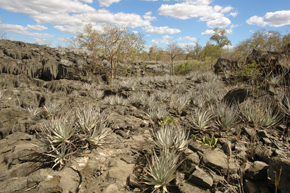
Claudio Nicoletti Fraga/JBRJ Encholirium fragae bromeliads grow on a limestone outcropping in the municipality of São Desidério, BahiaClaudio Nicoletti Fraga/JBRJ
Following a seven-year effort, a group of 575 botanists from Brazil and 14 other countries has completed the latest version of an extensive survey of the diversity of Brazilian plants, algae and fungi, currently tallied at 46,097 species. Nearly half of these, or 43%, are exclusive (endemic) to the national territory. That total qualifies Brazil as the country with the world’s richest plant diversity. The first version of the survey, published in 2010, listed 40,989 species. The number will only continue to grow at this rapid pace, as new species continue to be identified and described in scientific journals. Botanists introduce about 250 new species per year on average.
Five papers presenting details of the second version of the List of Species of the Brazilian Flora were published in December 2015 in Rodriguésia, the journal of the Rio de Janeiro Botanical Garden (JBRJ), in commemoration of its 80th year of publication. The issue also raises cautions about continuing losses of unique plant varieties. During the course of the survey, a group of botanists identified a new species of bromeliad with a red inflorescence—Aechmea xinguana—in a forested area now beneath the waters of the reservoir for the Belo Monte power plant, currently under construction in northern Pará State. “A few specimens of this species were rescued and kept in the reservoir’s greenhouse, but the natural populations in the flooded area were lost,” says Rafaela Campostrini Forzza, a JBRJ researcher who headed the survey.
But the work is not finished. In March 2016, specialists in each plant group are set to begin recording the descriptions, detailed geographic distribution and other characteristics of each species in the online database Flora do Brasil (floradobrasil.jbrj.gov.br), which will serve as a basis for Flora do Brasil Online, expected to be completed by 2020 as part of World Flora Online, a repository of data on all of the world’s known plants. Following in the footsteps of the botanists, in December 2015 the zoologists also organized and presented the first version of the Taxonomic Catalog of the Brazilian Fauna (TCBF). This list is the product of the efforts of some 500 experts, who have begun providing detailed information on 116,092 species, mostly arthropods that account for nearly 94,000 species, or 85% of the total.
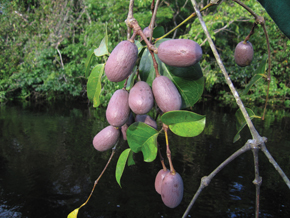
Denise Sasaki/Flora Cristalino Program Female plant of the Gnetum leyboldii species in Cristalino State Park, Mato Grosso, one of the six species of Gnetum in the Amazon: what look like fruit are actually seedsDenise Sasaki/Flora Cristalino Program
Prepared at the request of the Brazilian Ministry of the Environment with funding from the federal government, private institutions and state foundations such as FAPESP, Flora do Brasil reveals that the Amazon hosts the largest diversity of gymnosperms, non-fruit-bearing exposed-seed plants that predominated between 300 million and 60 million years ago, when dinosaurs roamed the Earth. The best-known representatives of this plant type are conifers typical of the cool climate of southern Brazil, such as the araucária, or Brazilian pine, of which there is a single species in Brazil, and four species of Podocarpus. Scattered amidst the forests of the North, however, are six species of broad-leaf vines of the genus Gnetum, which grow in the hot, moist climate around trees. Their red or light purple seeds bear such a resemblance to fruits that they once fooled botanists.
The nearly 50,000 specimens of native species rank Brazil as the continental country with the world’s greatest species diversity, followed by China, Indonesia, Mexico and South Africa. In number of endemic species, it ranks only behind large islands such as Australia, Madagascar and Papua New Guinea, whose isolation promotes the formation of unique varieties, and just one continental area, the Cape of Good Hope, in South Africa. The total number of species is less than the 60,000 cited in the most optimistic estimates, but surpasses that of Colombia, once considered to have the greatest diversity in South America; and it is more than twice the 22,767 species described in the monumental Flora brasiliensis, a 15-volume collection of 10,367 pages written by 65 botanists from several countries under the leadership of Carl Friedrich Philipp von Martius, August Wilhelm Eichler and Ignatz Urban, and published between 1840 and 1906.
In Flora brasiliensis, the predominant group, with 32,813 species, are the angiosperms, plants with seeds protected by fleshy or dry fruits. This group includes trees such as ipê and rosewood, roses and other ornamental species, beans, peanuts, corn and most vegetables used for consumption. In the case of beans alone, which belong to the genera Vigna, Canavalia and Phaseolus, Brazilian flora include about 30 native and naturalized species, “most of which have human consumption potential that has been scarcely investigated to date,” comments Vinicius Souza, a professor at the Luiz de Queiroz College of Agriculture of the University of São Paulo (ESALQ – USP), who was involved in producing and organizing the information for this work.
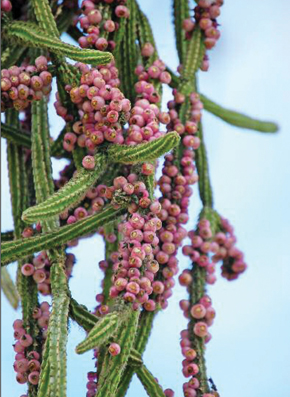
Gerardus OolstromRhipsalis flagelliformis, a cactus species found exclusively in Rio de JaneiroGerardus Oolstrom
The angiosperms dispersed when the climate turned hot and moist, after the extinction of the dinosaurs. Climate change eliminated most of the gymnosperms, which are now rarely found anywhere in the world. Botanists have found only 30 species of this group in Brazil—23 of them native. For their part, samambaias (tree ferns) and lycophytes—seedless, flowerless plants that reproduce by way of spores and are also ancient in origin, are represented in Brazil by 1,253 species. Some of these plants grow as tall as 20 meters, calling to mind the gigantic varieties that punctuated the terrestrial landscape 300 million years ago.
Joy and uneasiness
The botanists now share the satisfaction of having seen one more stage of the project concluded. Yet, at the same time there is a troublesome uneasiness, because they aware of the unequal geographic distribution of the collections of plant specimens on which the work was based. There was much more information on the South and Southeast regions—where the collections, groups of experts and research institutions are concentrated—than on other parts of the country. While there were 5.8 collections per square kilometer (km2) in the state of Rio de Janeiro and 3.9 per km2 in Espírito Santo State, the states of Pará and Amazonas accounted for only 0.10 and 0.17 per km2, respectively.
It is likely due to the number of collections beyond the botanists’ targeted figure that the state of Amazonas ranks third in diversity among the states, after Minas Gerais and Bahia. The botanists are not satisfied with this result. “In Amazonas there may be at least 20,000 species that have not yet been sampled,” Souza says.
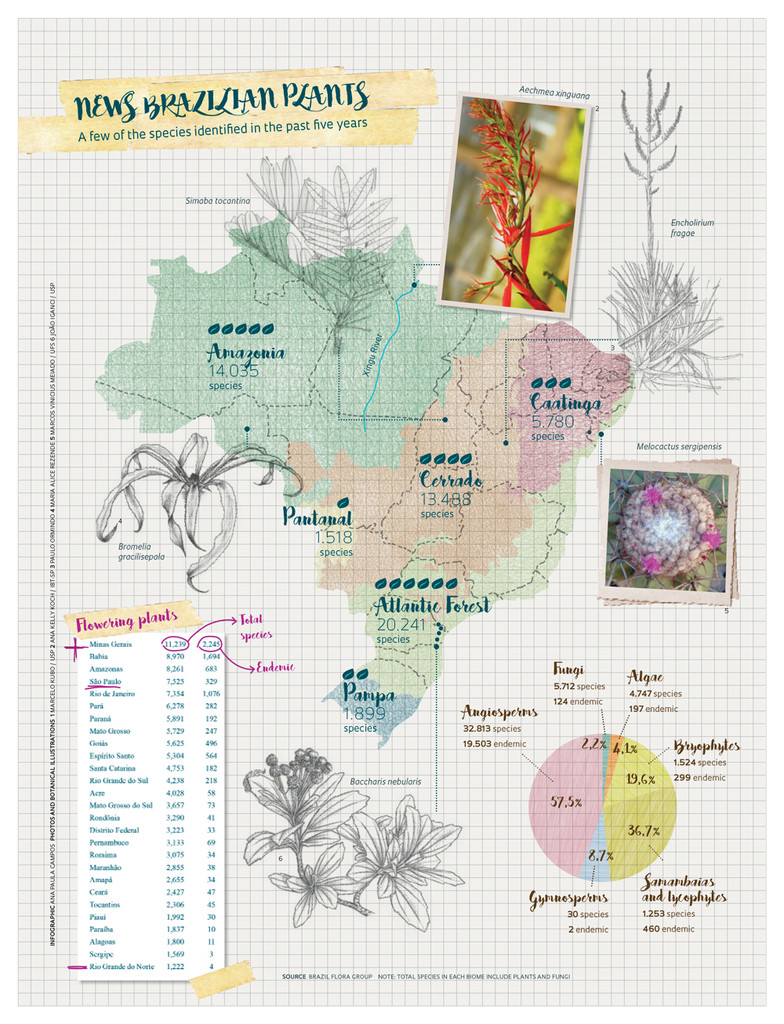 São Paulo ranks fourth in diversity. Besides having been well-covered by botany expeditions, the state has several terrain types, ranging from plains in the west to mountains in the east. It also hosts a variety of vegetation types—a situation conducive to the formation of new species. “Both cool-climate vegetation types typical of the south, and warm-climate types such as those found in the Cerrado savannah, have a home in São Paulo,” says José Rubens Pirani, a professor at the USP Biosciences Institute (IB – USP) (see table on page 45).
São Paulo ranks fourth in diversity. Besides having been well-covered by botany expeditions, the state has several terrain types, ranging from plains in the west to mountains in the east. It also hosts a variety of vegetation types—a situation conducive to the formation of new species. “Both cool-climate vegetation types typical of the south, and warm-climate types such as those found in the Cerrado savannah, have a home in São Paulo,” says José Rubens Pirani, a professor at the USP Biosciences Institute (IB – USP) (see table on page 45).
“Unfortunately, we have retained the distortions noted in the work of Von Martius, who collected primarily in the Atlantic Forest, the Caatinga scrubland and the Cerrado and rarely spent time in the Amazon,” says Forzza. “We need a national plan for mapping plant species in the Amazon Forest in order to solve the problem of undersampling in the country’s largest biome, which covers half of the Brazilian territory.”
The survey, developed from information available in herbaria and in online databases such as Reflora—which currently contains 1,390,218 records of native plants (see Pesquisa FAPESP Issue nº 229)—cites the Atlantic Forest as the biome with the greatest diversity of angiosperms, samambaias, lycophytes and fungi, owing to its larger number of collections and variety of altitudes, climates and latitudes. The Amazon ranks in second place, followed by the Cerrado.
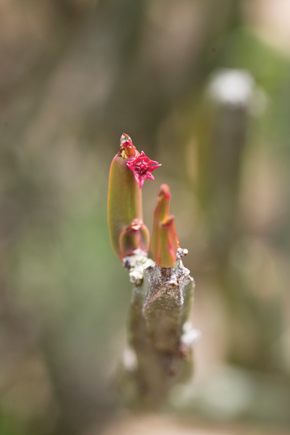
EDUARDO CESARBecoming acclimatized in the city of São Paulo: flower and fruit of Euphorbia attastoma, a cactus endemic to the Serra de Grão Mogol mountains, Minas Gerais, with phosphorescent latexEDUARDO CESAR
“We’re still a long way from what are likely to reflect real numbers,” Souza observes. “The more collections per region or state, the larger the number of species.” It is testament to his claim that, as a result of more collections, plant diversity increased 70% in the state of Tocantins and 40% in Piauí, compared to the numbers recorded in the first version of the Flora in 2010. “We weren’t working there, so the plants didn’t show up,” Pirani comments. In 2013, he and his team identified Simaba tocantina, a new species of shrub, in a little-known inland part of the Cerrado and in the vicinity of Jalapão State Park in eastern Tocantins, which features vast sand dunes reminiscent of those described in the book Grande sertão: veredas (The Devil to Pay in the Backlands), by Guimarães Rosa.
In the North, the less-scrutinized areas are the most likely scenarios for the development of new soybean and sugarcane plantations. “Deforestation is occurring much faster than our ability to learn about the forest,” says São Paulo botanist Daniela Zappi, a researcher at Kew Gardens in London. “It’s a desperate situation. It looks like there won’t be enough time to get to those areas—in particular the Arc of Deforestation, between northern Mato Grosso and southern Pará.”
The Cactaceae, one of her specialty plant groups, are highly diverse in Brazil: there are 103 species in Minas Gerais and 98 in Bahia, but 32% of the 260 species in this group are endangered at varying levels. Their habitats are continually being replaced by eucalyptus plantations, or farming or mining operations. Cacti are exploited as ornamental plants and collected as feed for cattle or humans, who also use them as a source for drugs, usually with no concern for replacing the original populations. Another problem arises from the fact that many species grow only in specific areas. Such is the case for Arrojadoa marylaniae, a columnar cactus with rings of red flowers that grows only on a commercially valuable deposit of white quartz in inland Bahia.
The work of identifying and studying the geographic distribution of each species is tied to a plan of action to study and promote pollination and germination of highly endangered species. Preservation activities include participation by researchers outside of academia. Gerardus Oolstrom, a commercial cactus grower in Holambra, São Paulo State, worked with botanists from academia to identify Rhipsalis flagelliformis, a new species that he first saw growing in a place that once belonged to landscape architect Roberto Burle Marx in the city of Rio de Janeiro’s Guaratiba neighborhood. “When they join forces with research groups, collectors can be of great help in the work of finding and preserving species,” Zappi notes.
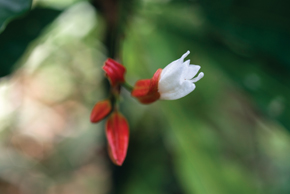
Eduardo CesarFlower of a japaranduba (Erythrochiton brasiliensis), a small tree that grows within unaltered sections of moist Atlantic ForestEduardo Cesar
Forzza is also working with Elton Leme, an attorney and amateur botanist, to describe three new species of the genus Encholirium that grow among rocks on hillsides in Bahia and Minas Gerais. For their part, researchers from the Belo Horizonte Zoobotanic Foundation disseminated “Wanted” posters with photos and information about the Faveiro-de-Wilson, a rare tree, and were able to locate many specimens with the help of residents of inland Minas Gerais (see Pesquisa FAPESP Issue nº 235).
“We don’t have to plant just roses and azaleas,” Pirani suggested as he walked along the wide, sun-filled corridors of the herbarium at IB-USP in early January 2016. “Growing native ornamental plants in our houses, along our streets and by the roadside is a way of preserving diversity.” He then pointed out a blue-flowering tree-lily shrub, the bromeliads gravatá and macambira, and other plants collected in the Serra de Grão Mogol mountains in northern Minas Gerais, that he is trying to adapt to the city’s climate. “It rains more here than in Minas, but even so, some of them flower all year long.”
Scientific articles
COSTA, D. P. e PERALTA, D. F. Bryophytes diversity in Brazil. Rodriguésia. V. 66, No. 4, p. 1063-71. 2015.
MAIA, L. C. et al. Diversity of Brazilian Fungi. Rodriguésia. V. 66, No. 4, p. 1033-45. 2015.
MENEZES, M. et al. Update of the Brazilian floristic list of Algae and Cyanobacteria. Rodriguésia. V. 66, No. 4, p. 1047-62. 2015.
PRADO, J. et al. Diversity of ferns and lycophytes in Brazil. Rodriguésia. V. 66, No. 4, p. 1073-83. 2015.
THE BRAZIL FLORA GROUP. Growing knowledge: an overview of seed plant diversity in Brazil. Rodriguésia. V. 66, No. 4, p. 1085-113. 2015.